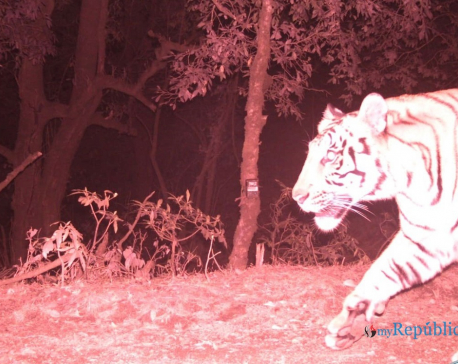
OR
Conservationists say tigers have been living in Kailali forests for a long time
Published On: February 25, 2021 01:40 PM NPT By: PUSHPARAJ JOSHI

KAILALI, Feb 25: After the death of 25-year-old Kala Dhami of Andaiya in Gauriganga Municipality-5 in a tiger attack on February 14, the stakeholders are curious as to where the tiger actually came from.
Many have speculated that the tiger may have come from India's Dudhwa National Park, while others have been claiming that tigers have been living in Kailali's national and community forests for years. Amid this discussion, conservationists have said that tigers have been living in Kailali for generations.
“After a person died in a tiger attack in Andaiya of Gauriganga Municipality, everyone has started asking as to where the tiger came from,” said Om Prakash Sapkota, chairman of the Community Forest Coordinating Committee, Masuriya. “But the tiger has been in Kailali for a long time and it happened to attack a human in search of food.”
He said that the tiger, in search of food, had reached the Andaiya-Taalband-Kandra Rajghat area from Basanta Protected Forest through the bypass route. “The tiger spotted in Nepal is not from India but is a local tiger that has been living in the jungle here for years,” Sapkota said. “The tiger was not spotted before because it used to stay in its area and speculations about its arrival from India grew stronger after it killed a human while it was out in search of food.”
He said that tigers have been living in Basanta, Rajghat, Andaiya, Taalband, Dudejhari, Barawan and Faliya Bisauani of Kailali for generations. “These areas are home to tigers,” he told Republica, “But people here have speculated that they might have come from outside the country because they were not seen before.” He claimed that the tigers have been residing in Kalali’s national and community forests for years.
Bijay Shrestha, another conservationist also said although people speculated the arrival of tigers from India as they started appearing near the settlement in recent times, they were already present in the forests of Nepal. “We kept saying that there are tigers in Kailali, no one believed us but now it is clear,” he added.
The census of tigers has shown that there are 19 tigers in the far western region. According to the Tiger Census 2018, there are 19 tigers in the Shuklaphanta National Park and surrounding forests (Laljhadi, Basanta Corridor) of the far-western region.
“The census shows the number of tigers in the region is 19,” said Shivaraj Bhatta, head of the World Wildlife Fund (WWF) conservation program, “They might have started venturing out in search of food.” He said that it is not a new thing to track the movement of tigers in the area because Andaiya-Taalband-Rajghat area is an old place where they have been residing for a long time.
You May Like This

Fear grips the village as tiger kills 11 goats in single day in Kailali
SUDURPASCHIM, August 3: Fear is looming large among the villagers after a tiger pounced and killed 11 goats in Mohoanyal... Read More...

Resham Chaudhary, accused in Kailali violence wins HoR poll from Kailali-1
Dhangadhi, Dec 12 :Resham Lal Chaudhary, the Rastriya Janata Party Nepal ( RJPN) candidate for the House of Representatives election... Read More...

Three injured in tiger attack
CHITWAN, July 19: Three persons have been injured in a tiger attack at Madi Municipality-3 on Tuesday. ... Read More...









Just In
- Forced Covid-19 cremations: is it too late for redemption?
- NRB to provide collateral-free loans to foreign employment seekers
- NEB to publish Grade 12 results next week
- Body handover begins; Relatives remain dissatisfied with insurance, compensation amount
- NC defers its plan to join Koshi govt
- NRB to review microfinance loan interest rate
- 134 dead in floods and landslides since onset of monsoon this year
- Mahakali Irrigation Project sees only 22 percent physical progress in 18 years









Leave A Comment